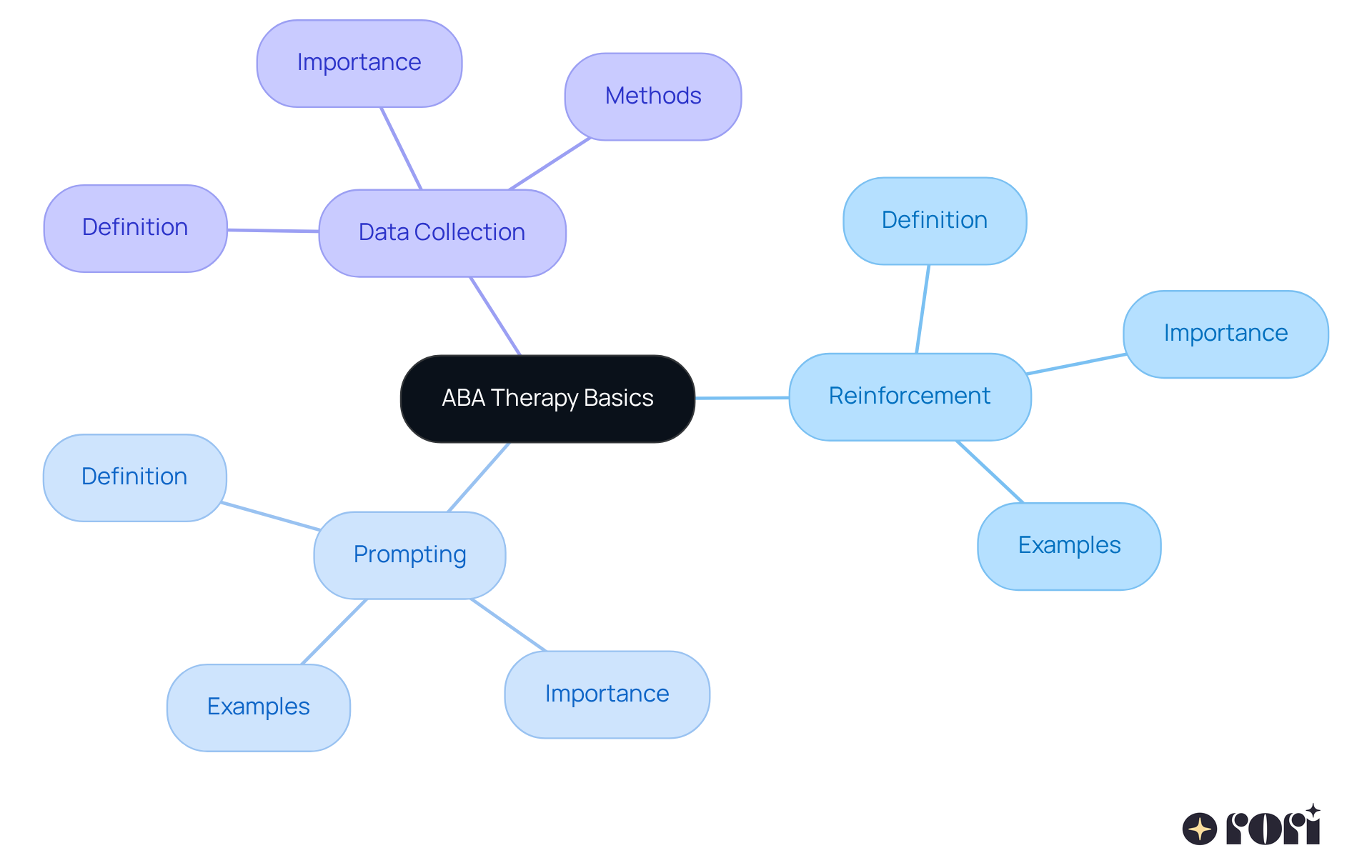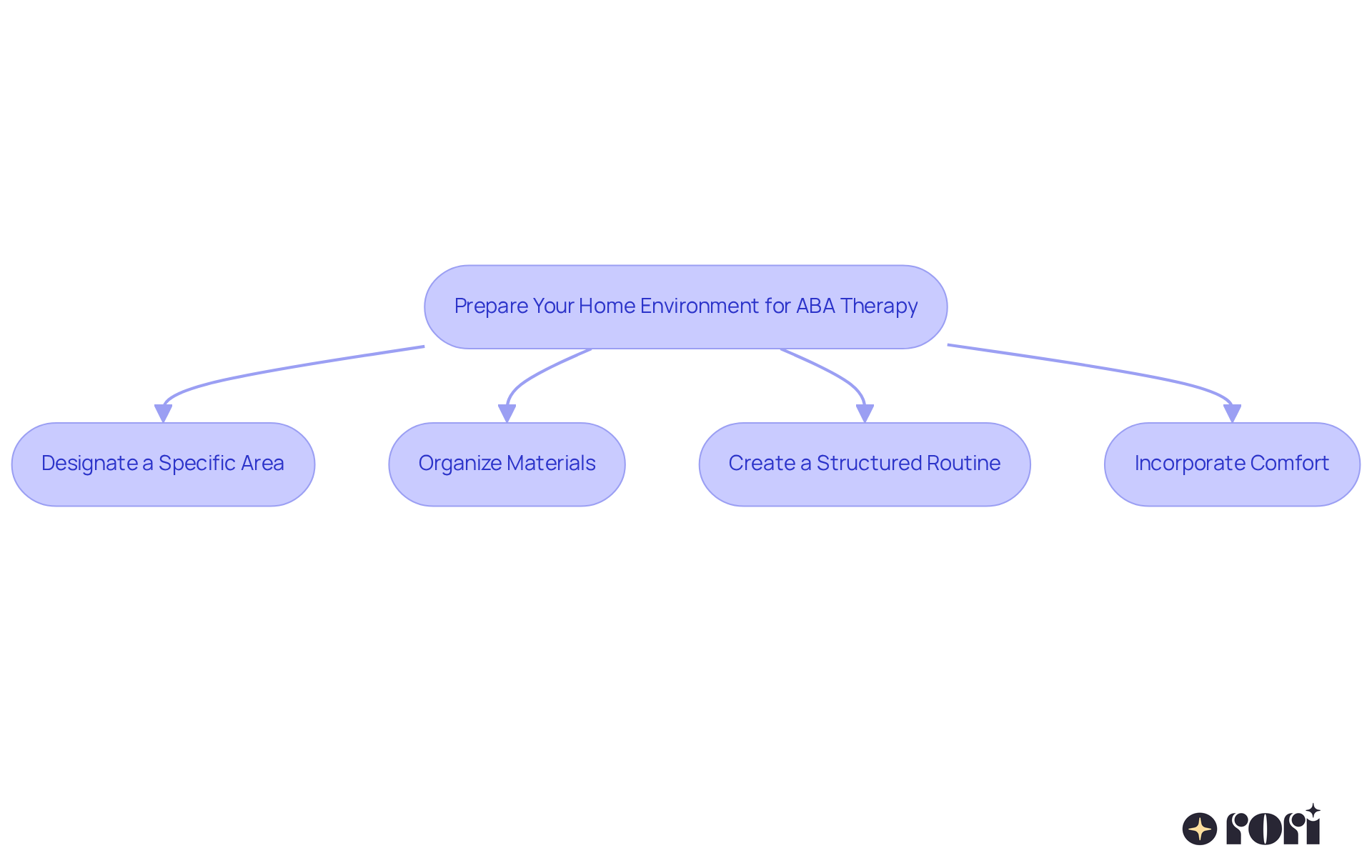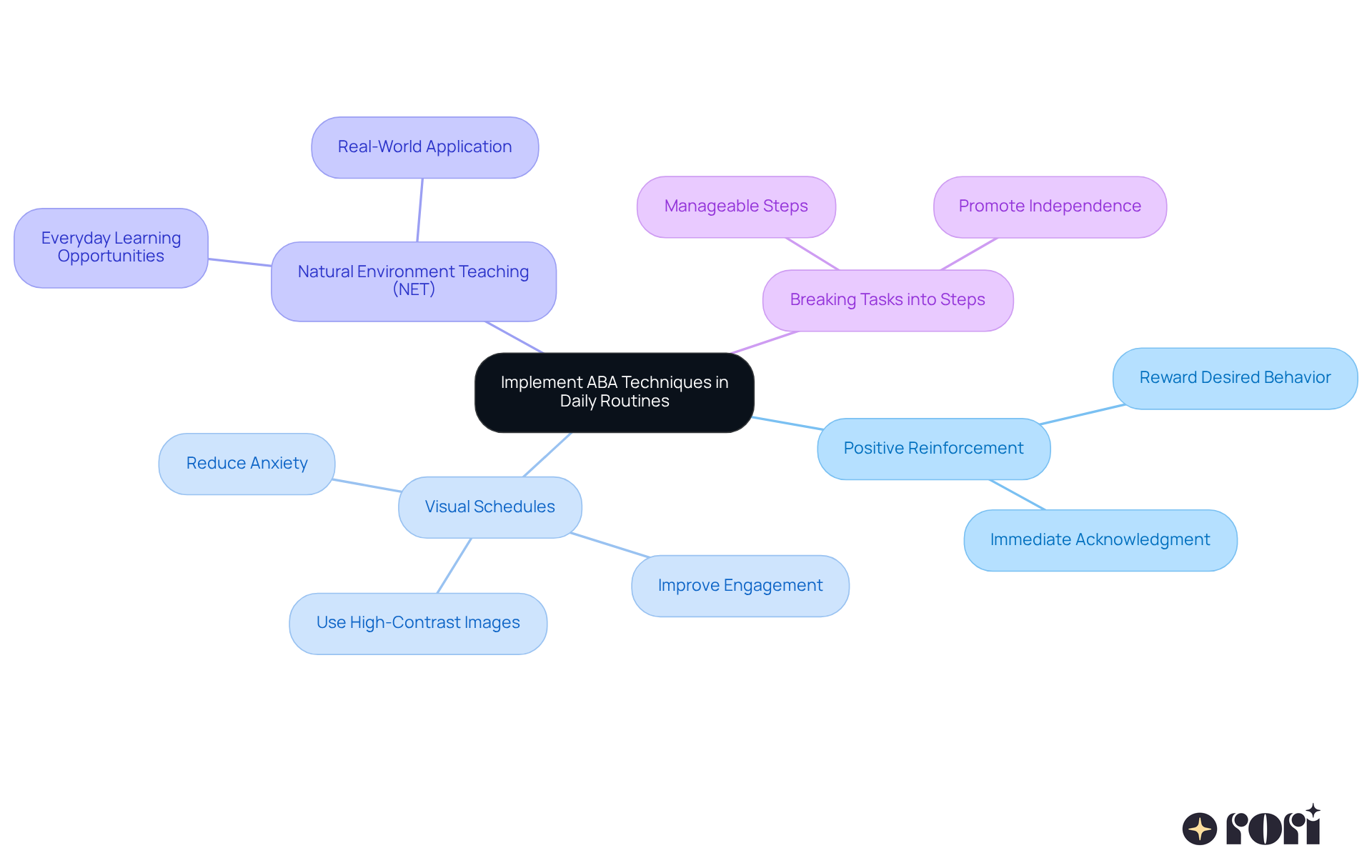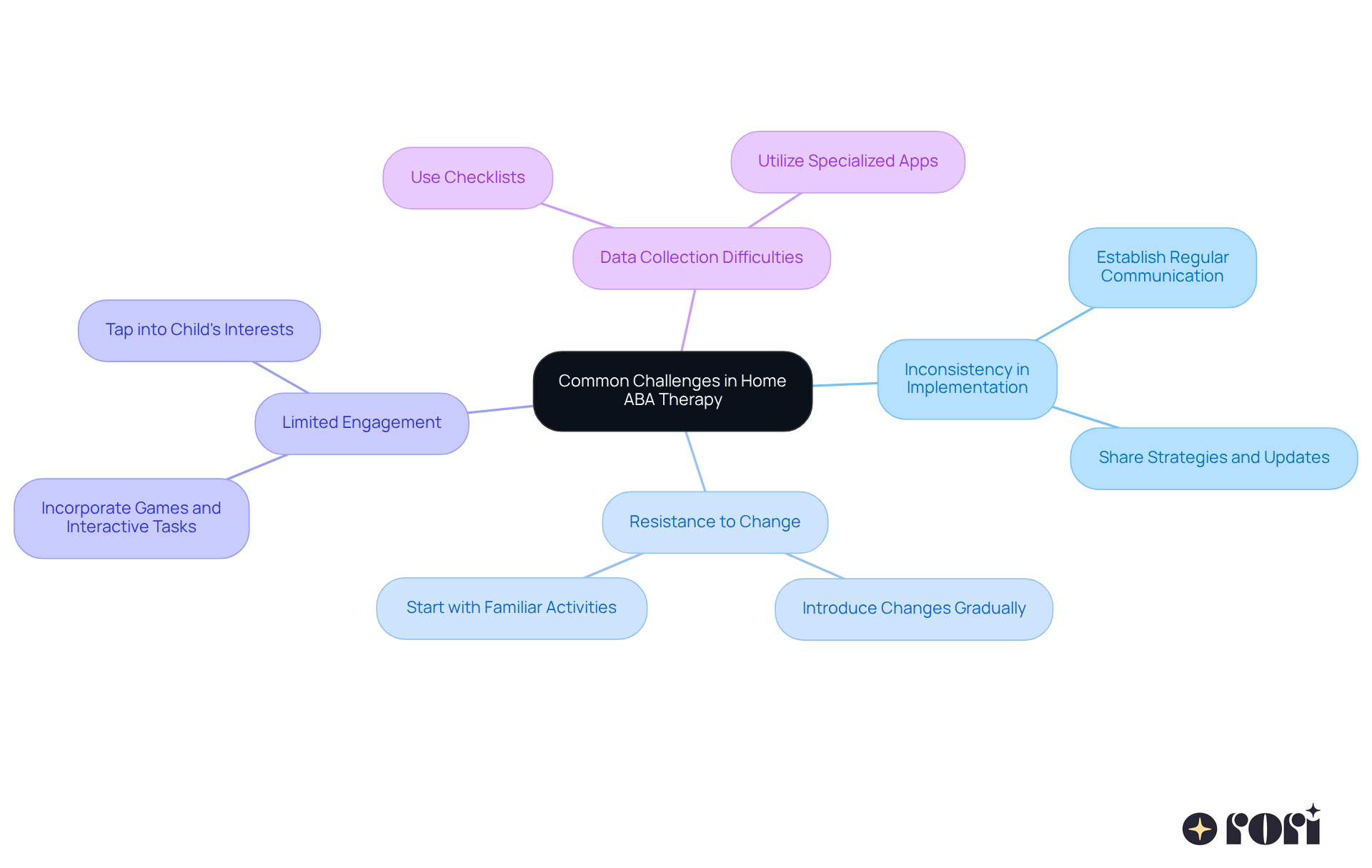This article shares four essential steps for providing free Applied Behavior Analysis (ABA) therapy at home for children with autism. It focuses on:
These steps are backed by evidence that shows how structured approaches, caregiver involvement, and consistent reinforcement can truly enhance the effectiveness of therapy and support your child's development.
Let’s explore this together! By grasping the principles of ABA, you can create a nurturing space that encourages growth. Preparing your home environment is like setting the stage for success—small changes can make a big difference! As you weave these techniques into daily routines, you’ll find that they seamlessly integrate into your family life. And remember, it’s perfectly normal to face challenges along the way; troubleshooting is part of the journey.
We’re here to help you every step of the way! With a little patience and persistence, you can make a significant impact on your child's journey. So, let’s dive in and embrace this rewarding experience together!
Creating a nurturing environment for children with autism is more important than ever. Families are on the lookout for effective and accessible resources, and free Applied Behavior Analysis (ABA) therapy at home offers a wonderful opportunity for parents to actively support their child's growth and development. Yet, many caregivers encounter challenges in effectively implementing these techniques.
So, how can families overcome these hurdles to truly maximize the benefits of ABA therapy in their daily lives? Let’s explore this together! 🌈
Applied Behavior Analysis (ABA) is a scientifically validated method designed to help improve specific actions and skills in children with autism. At its core, ABA focuses on modifying behavior through structured techniques. Let’s dive into some key concepts that can really make a difference:
Reinforcement: This principle is all about providing a reward after a desired behavior to encourage it to happen again. For example, when you praise your child for following a direction, you’re reinforcing that behavior, making it more likely to occur in the future. Research shows that effective reinforcement strategies can significantly enhance behavioral outcomes, with studies indicating that positive reinforcement leads to greater engagement and skill development in kids with autism.
Prompting: This technique involves giving cues or hints to encourage a desired response. For instance, if your child struggles to say 'thank you,' you might gently prompt them by asking, 'What do you say?' after they receive something. This not only helps them develop their skills but also fosters their independence as they learn how to respond appropriately in social situations.
Data Collection: Keeping track of progress is vital in ABA. By documenting your child’s behaviors, you can identify trends and assess their progress over time. Recent research emphasizes that organized data gathering boosts the efficiency of interventions, allowing for timely adjustments to treatment plans based on individual needs.
By understanding these foundational principles, you can effectively support your child's learning and development through ABA techniques at home. Together, we can create an environment that nurtures growth and independence. Let’s explore this journey together!

Creating an effective home environment for free aba therapy at home can truly make a difference for your child! Here are some friendly suggestions to help you get started:
Designate a Specific Area: Choose a quiet, low-traffic spot in your home for those important counseling sessions. This space should be free from distractions like loud noises or visual clutter, allowing your child to focus better.
Organize Materials: Keep essential materials—like visual schedules, reinforcers such as stickers or tokens, and educational toys—neatly organized and easily accessible. Using bins or shelves can help you maintain a clutter-free environment that promotes engagement.
Create a Structured Routine: Establishing a consistent schedule for treatment sessions is key. Children with autism thrive on structure, so having set times for sessions helps them know what to expect, fostering a sense of safety and collaboration. Did you know that studies show 66% of youth referred for ABA treatment start sessions and stay in services for 12 months? This highlights the importance of consistency! Plus, when caregivers are actively involved, significant progress is noted in 90% of youngsters. It’s also worth mentioning that ABA intervention is the only scientifically proven treatment for autism covered by insurance, making it accessible for families.
Incorporate Comfort: Make your space inviting and accessible by ensuring appropriate seating and lighting. Consider using kid-friendly furniture to enhance comfort and motivate your little one to engage in the treatment process. Adding sensory tools like weighted blankets and fidget toys can also help create a supportive environment tailored to your child's unique needs.
By thoughtfully preparing your home environment, you can create a nurturing space that significantly enhances the effectiveness of free aba therapy at home. Equipping caregivers with an understanding of ABA principles and strategies not only strengthens the skills acquired during sessions but also amplifies the intervention's impact. Remember, active family involvement is essential for successful outcomes. Let’s explore this together!

To effectively implement ABA techniques in your child's daily routines, let's explore some helpful strategies together:
Use Positive Reinforcement: Reward your child right after they show a desired behavior. For example, if they clean up their toys, offer some praise or a small treat. This immediate acknowledgment reinforces positive actions and encourages them to repeat those behaviors.
Incorporate Visual Schedules: Create a visual schedule that outlines daily activities. Research shows that visual schedules can significantly reduce anxiety and improve engagement by providing predictability. Using high-contrast images or actual photographs can help your little one understand what to expect throughout the day, making transitions smoother.
Practice Natural Environment Teaching (NET): Use everyday situations as learning opportunities. During grocery shopping, for instance, you can practice counting items or identifying colors. This method not only strengthens learning but also helps your child apply skills in real-world situations.
Break Tasks into Steps: For more complex tasks, break them down into smaller, manageable steps. This strategy enhances understanding and success rates, as young learners can focus on accomplishing one step at a time. Visual schedules can be particularly effective here, clearly outlining each step and promoting independence and self-management.
By embedding these ABA techniques into daily routines, you're creating a rich learning environment that supports your child's development and helps them thrive, especially with free aba therapy at home. Remember, we’re here to help you every step of the way!

While free aba therapy at home can come with its own set of challenges, don’t worry—you’re not alone! Let’s explore some common issues and effective strategies to tackle them together:
Inconsistency in Implementation: It’s vital that all caregivers are on the same page with ABA techniques. Establish regular communication channels to share strategies and updates. This way, everyone can maintain a unified approach, which is key for effective behavior change. Research shows that caregiver consistency can really influence therapy outcomes, helping your little one make great strides!
Resistance to Change: If your child seems hesitant about new routines or techniques, try introducing changes gradually. Begin with familiar activities to ease them into new concepts, making the transition feel less overwhelming.
Limited Engagement: To keep your child engaged during sessions, mix things up! Incorporate games and interactive tasks that tap into their interests. This not only keeps their attention but also boosts motivation. Engaging methods can lead to better retention of skills and concepts.
Data Collection Difficulties: It’s easy to feel overwhelmed by data collection, but it doesn’t have to be complicated. Simplify your methods by using checklists or specialized apps designed for tracking ABA progress. This way, you can monitor advancements without the added stress.
By proactively addressing these challenges and implementing these strategies, you can significantly enhance the effectiveness of free aba therapy at home. Together, we can create a supportive environment that nurtures your child's growth!

Creating a supportive and effective environment for free ABA therapy at home is so important for the development of children with autism. By grasping the foundational principles of Applied Behavior Analysis—like reinforcement, prompting, and data collection—caregivers can truly enhance their child's learning experience. These techniques not only promote skill acquisition but also encourage independence, paving the way for long-term success.
In this guide, we’ve outlined essential strategies to prepare your home environment, implement ABA techniques in daily routines, and tackle common challenges. From setting up a quiet space and organizing materials to using positive reinforcement and visual schedules, each step helps create a nurturing atmosphere where children can thrive. Plus, addressing issues like inconsistency and resistance to change keeps therapy effective and engaging.
Ultimately, integrating ABA therapy into home life is a collaborative journey that calls for patience and commitment. By actively involving caregivers and utilizing the insights shared here, families can build a rich learning environment that not only supports their child's growth but also enhances their overall quality of life. Embracing these strategies empowers families to navigate the complexities of ABA therapy, making it a rewarding experience for both children and caregivers alike. Let’s explore this together!
What is Applied Behavior Analysis (ABA)?
Applied Behavior Analysis (ABA) is a scientifically validated method designed to help improve specific actions and skills in children with autism by modifying behavior through structured techniques.
What is the principle of reinforcement in ABA?
Reinforcement in ABA involves providing a reward after a desired behavior to encourage it to happen again. For example, praising a child for following a direction reinforces that behavior, making it more likely to occur in the future.
How does reinforcement impact children with autism?
Research shows that effective reinforcement strategies can significantly enhance behavioral outcomes, leading to greater engagement and skill development in children with autism.
What is prompting in the context of ABA?
Prompting is a technique that involves giving cues or hints to encourage a desired response. For instance, if a child struggles to say 'thank you,' a parent might prompt them by asking, 'What do you say?' after they receive something.
Why is prompting important for children with autism?
Prompting helps children develop their skills and fosters their independence as they learn to respond appropriately in social situations.
What role does data collection play in ABA?
Data collection is vital in ABA as it involves keeping track of a child's behaviors to identify trends and assess progress over time. Organized data gathering boosts the efficiency of interventions and allows for timely adjustments to treatment plans based on individual needs.
How can parents support their child's learning through ABA techniques?
By understanding the foundational principles of ABA, parents can effectively support their child's learning and development at home, creating an environment that nurtures growth and independence.